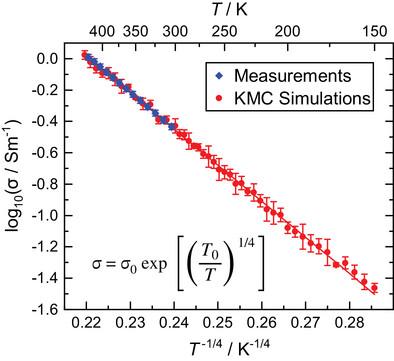当前位置:
X-MOL 学术
›
Adv. Electron. Mater.
›
论文详情
Our official English website, www.x-mol.net, welcomes your
feedback! (Note: you will need to create a separate account there.)
Variable‐Range Hopping Conduction in Amorphous, Non‐Stoichiometric Gallium Oxide
Advanced Electronic Materials ( IF 5.3 ) Pub Date : 2024-11-04 , DOI: 10.1002/aelm.202400407 Philipp Hein, Tobias Romstadt, Fabian Draber, Jinseok Ryu, Thorben Böger, Andreas Falkenstein, Miyoung Kim, Manfred Martin
Advanced Electronic Materials ( IF 5.3 ) Pub Date : 2024-11-04 , DOI: 10.1002/aelm.202400407 Philipp Hein, Tobias Romstadt, Fabian Draber, Jinseok Ryu, Thorben Böger, Andreas Falkenstein, Miyoung Kim, Manfred Martin

|
Amorphous, non‐stoichiometric gallium oxide (a‐GaOx x < 1.5) is a promising material for many electronic devices, such as resistive switching memories, neuromorphic circuits and photodetectors. So far, all respective measurements are interpreted with the explicit or implicit assumption of n‐type band transport above the conduction band mobility edge. In this study, the experimental and theoretical results consistently show for the first time that for an O/Ga ratio x of 0.8 to 1.0 the dominating electron transport mechanism is, however, variable‐range hopping (VRH) between localized states, even at room temperature and above. The measured conductivity exhibits the characteristic exponential temperature dependence on T −1/4 , in remarkable agreement with Mott's iconic law for VRH. Localized states near the Fermi level are confirmed by photoelectron spectroscopy and density of states (DOS) calculations. The experimental conductivity data is reproduced quantitatively by kinetic Monte Carlo (KMC) simulations of the VRH mechanism, based on the ab‐initio DOS. High electric field strengths F cause elevated electron temperatures and an exponential increase of the conductivity with F 1/2 . Novel results concerning surface oxidation, magnetoresistance, Hall effect, thermopower and electron diffusion are also reported. The findings lead to a new understanding of a‐GaOx x
中文翻译:

非晶态、非化学计量氧化镓中的变范围跳跃传导
非晶态非化学计量氧化镓 (a-GaOx, x < 1.5) 是一种很有前途的材料,可用于许多电子设备,例如电阻式开关存储器、神经形态电路和光电探测器。到目前为止,所有相应的测量都是通过导带迁移率边缘上方 n 型频带传输的显式或隐含假设来解释的。在这项研究中,实验和理论结果首次一致表明,对于 0.8 至 1.0 的 O/Ga 比 x,然而,主要的电子传输机制是局域状态之间的可变范围跳跃 (VRH),即使在室温及以上。测得的电导率表现出对 T-1/4 的特征指数温度依赖性,这与 Mott 的标志性 VRH 定律非常一致。费米能级附近的局域态通过光电子能谱和状态密度 (DOS) 计算得到证实。实验电导率数据通过基于从头 DOS 的 VRH 机制的动力学蒙特卡洛 (KMC) 模拟定量再现。高电场强度 F 会导致电子温度升高,并且 F1/2 的电导率呈指数级增加。还报道了有关表面氧化、磁阻、霍尔效应、热功率和电子扩散的新结果。这些发现导致了对 a-GaOx 器件的新理解,也包括关于金属|a-GaOx 肖特基势垒。
更新日期:2024-11-04
中文翻译:

非晶态、非化学计量氧化镓中的变范围跳跃传导
非晶态非化学计量氧化镓 (a-GaOx, x < 1.5) 是一种很有前途的材料,可用于许多电子设备,例如电阻式开关存储器、神经形态电路和光电探测器。到目前为止,所有相应的测量都是通过导带迁移率边缘上方 n 型频带传输的显式或隐含假设来解释的。在这项研究中,实验和理论结果首次一致表明,对于 0.8 至 1.0 的 O/Ga 比 x,然而,主要的电子传输机制是局域状态之间的可变范围跳跃 (VRH),即使在室温及以上。测得的电导率表现出对 T-1/4 的特征指数温度依赖性,这与 Mott 的标志性 VRH 定律非常一致。费米能级附近的局域态通过光电子能谱和状态密度 (DOS) 计算得到证实。实验电导率数据通过基于从头 DOS 的 VRH 机制的动力学蒙特卡洛 (KMC) 模拟定量再现。高电场强度 F 会导致电子温度升高,并且 F1/2 的电导率呈指数级增加。还报道了有关表面氧化、磁阻、霍尔效应、热功率和电子扩散的新结果。这些发现导致了对 a-GaOx 器件的新理解,也包括关于金属|a-GaOx 肖特基势垒。


















































 京公网安备 11010802027423号
京公网安备 11010802027423号